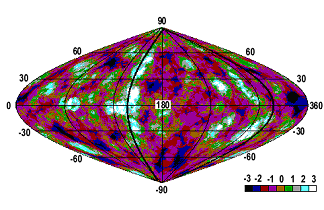Recent results: Extragalactic component?
Extragalactic component?
In order to analyse arrival directions of EAS events at the highest energies, we have selected showers detected with E>8 EeV, zenith angle q<600, axes within array area, and where at least four detector stations data are used to derive arrival direction angles. A total of 559 showers were found this way. In addition, we used 522 events detected with SUGAR array. These showers are mostly from the Earth’s Southern hemisphere. Together with the Yakutsk array data they give a fairly complete picture of UHECR distribution in the surrounding space. The accuracy with which the directions of air showers were determined is about 50.
We used the deviation of the observed number of events N from the expected-for-isotropy number N0 in units of the r.m.s.: (N-N0)/ÖN0, where N and N0 are numbers of EAS in the solid angles with opening angles 80 and 450, respectively. The values of deviations were found when a 10*10 area was sequentially displaced over the entire sphere.

Figure shows the relative deviations of UHECR flux (E>8 EeV) in Galactic coordinates. Numerous local regions of positive and negative, high and low, excess around expected-for-isotropy values are seen over the entire sphere. This suggests that the UHECR anisotropy, if exists, is multipolar in pattern.
No excess flux is observed from the Galactic Disk, except the spot at lG=137.40 where Galactic and Supergalactic planes intersect. There is no slightest hint at an excess flux even from the Galactic Center, where the most active and powerful matter conversion processes take place. There is no excess flux at the exit of the Local Galactic Arm either. These facts probably indicate the minor role the Galaxy plays in generation of particles in the energy region above 8 EeV.
A completely different picture opens up in the Supergalaxy. A correlation between UHECR arrival directions and the Supergalctic Plane (shown by solid curve) is seen in the Northern hemisphere. A pronounced excess in the sector lSGÎ(00-2100), with its maximum at lSG=1200 is also seen. However, there is no such clear correlation in the Southern Hemisphere, except the local region of the sky with equatorial coordinates α=00 and δ=-850. Curiously, it lies near the Supergalactic plane in a direction that is almost opposite to that of the Northern hemispere. A whole picture indicates a dominant role the Supergalaxy (Local Supercluster of galaxies) plays in forming the excess cosmic ray flux at energies above 8 EeV.
